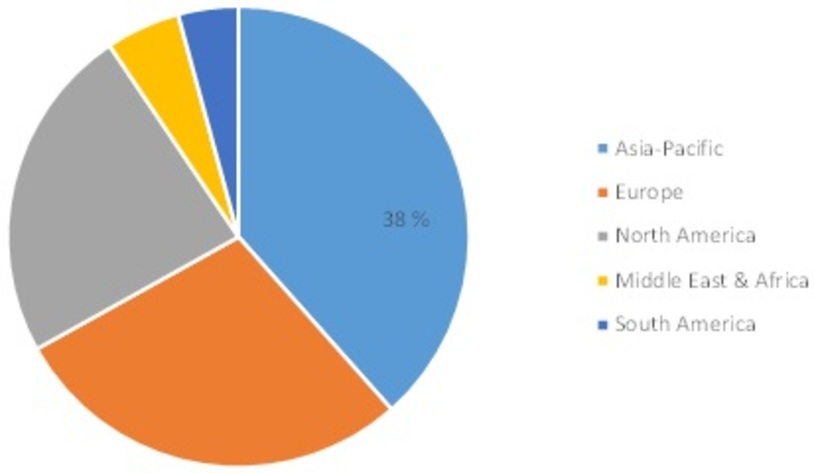Global Aerospace Robotics Market.
The Aerospace Robotics Market expected to reach value at USD 31.58 Billion by 2030 and is estimated to register a CAGR of 11.7% by 2022-2030.
Asia-Pacific Emerged to Be the Fastest-Growing Market for Aerospace Robotics During the Review Period. Asia-Pacific is an emerging and leading market for robotics technology. Major countries with the highest number of robot-based aerospace applications include South Korea, Japan, China, and India. Advancements in sensor-based technologies are propelling the demand for aerospace robotics in Asia-Pacific. There is a high demand for robots integrated with machine-to-machine sensors and robotic intelligence, suitable for use in aerospace and industrial environments.
North America is one of the earliest adopters of robotics, owing to the rapid adoption of smart factories and industrial automation. The region is also one of the leading robotics manufacturing markets after Europe and Asia. For instance, the number of robots sold in 2021 increased by 28% over 2020, according to industry statistics provided by the Association for Advancing Automation (A3).
The use of automated testing equipment in electronics for better calibration of devices enhances the production of testing equipment, inducing growth for the aerospace robotics market. Many major players adopt various business strategies for their robotics segment revenue growth. For instance, within the MEA region, the need for automation in various industries – from food to metal works – has risen dramatically in recent years.
The market in South America is expected to show significant growth during the forecast period due to the increasing investments in various advanced technologies and investments from major regions such as North America to set up factories in this region. The government’s pro-growth policies and rise in spending of industries have increased the number of multinational expansion plans. Brazil and Colombia are among the fastest-growing countries in South America. Furthermore, enterprises in this region highly emphasize innovation.
Global Aerospace Robotics Market Share, by Region, 2021 (%) Source: MRFR Analysis
Source: MRFR Analysis
Covid Impact Analysis
Covid-19 pandemic, climate variations, civil unrest, and depletion of natural resources impact the cost and supply of raw materials. Today, electronic component has become an important part of aerospace robotics. Though robotics parts still have a major share in aerospace robotics, there has been a rising use of other electrical components and semiconductors in aerospace robotics. Critical components required for aerospace robotics, such as capacitors and resistors, were in shortage due to manufacturing hubs' closure and production delays. A vast majority of the workforce had to stay home. Businesses had to track and adapt to changing policies and political climates across the globe, cater to customers and protect employees.
Segentation
The global aerospace robotics market has been segmented on the basis of type, component, payload, application, and region.
The global aerospace robotics market, based on type, market is segmented into traditional robots and collaborative robots. The traditional robots, the market has been sub-segmented into articulated, parallel, linear/cartesian, SCARA and others. The SCARA segment is expected to exhibit the highest CAGR of 11.1% during the forecasted period.
The global market, based on component, is segmented into controller, sensor, drive, end effector and others. Based on end effector sub-segmented into welding guns, grippers, robotic screwdrivers, sanding & deburring tool, specialty & hybrid end effectors and others.
The global aerospace robotics market, based on payload, has been segmented into Up to 16.00 kg, 16.01–60.00 kg, 60.01–225.00 kg and more than 225.00 kg. Among these, the Up to 16.00 kg segment is likely to contribute the largest market share during the review period.
The global aerospace robotics market, based on application, is segmented into drilling & fastening, non-destructive testing & inspection, welding & soldering, sealing & dispensing, handling, assembling & disassembling, and others.
The global market, based on region is bifurcated into North America, Europe, Asia-Pacific, South America, and the Middle East & Africa.
Key Players
Some of the prominent players operating in the global aerospace robotics market include Kuka AG, ABB Group, FANUC Corporation, Yaskawa electric corporation, Kawasaki Heavy Industries Ltd, Mtorres, Oliver Crispin Robotics Limited, Gudel AG, Electroimpact Inc., Universal Robots A/S, STÄUBLI, COMAU, FESTO, and BOSTON DYNAMICS.
Leading companies partner with us for data-driven Insights
Kindly complete the form below to receive a free sample of this Report
| Companies Covered | 15 |
| Pages | 100 |
Certified Global Research Member


Why Choose Market Research Future?
- Vigorous research methodologies for specific market.
- Knowledge partners across the globe
- Large network of partner consultants.
- Ever-increasing/ Escalating data base with quarterly monitoring of various markets
- Trusted by fortune 500 companies/startups/ universities/organizations
- Large database of 5000+ markets reports.
- Effective and prompt pre- and post-sales support.
Tailored for You
- Dedicated Research on any specifics segment or region.
- Focused Research on specific players in the market.
- Custom Report based only on your requirements.
- Flexibility to add or subtract any chapter in the study.
- Historic data from 2014 and forecasts outlook till 2040.
- Flexibility of providing data/insights in formats (PDF, PPT, Excel).
- Provide cross segmentation in applicable scenario/markets.







